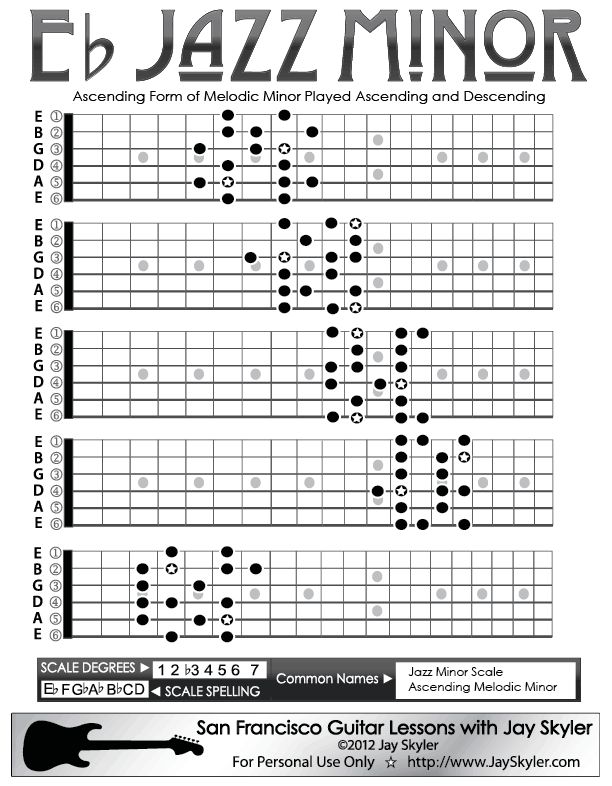Jazz (Ascending Melodic) Minor Scale Guitar Fretboard Patterns- Chart, Key of A
by Jay SkylerGuitar Lesson Summary & Chart Explanation
Jazz (Ascending Melodic) Minor Scale on Guitar
Although this site is specifically oriented (read biased) toward Rock, Blues, and Metal guitar styles, I had a lot of requests for this so I decided to make a chart for it.The Jazz Minor vs. the Melodic Minor Scale
The Jazz Minor scale is derived from the Melodic Minor scale. The Melodic Minor scale is a scale used by composers in European Classical music. It was used mainly for pieces that were performed by singers, rather than the primarily instrumental compositions we tend to associate with Classical Music. To understand the origin of Melodic Minor we must understand a little bit about the Harmonic Minor scale.
Melodic vs. Harmonic Minor
Melodic Minor came about as a modification to the Harmonic Minor scale . Harmonic Minor is the Natural Minor Scale with a raised seventh scale degree (i.e. The Natural Minor has a flatted seventh scale degree, but the Harmonic Minor has a Natural Seventh Scale Degree like the Major Scale). See:
Natural Minor Guitar Scale Patterns
The point of this modification to the Natural Minor scale is to make the fifth chord of the key a Dominant 7th chord, which we would write out using the Roman Numeral System as V7. Natural Minors fifth chord is usually a minor or minor 7th (V-7). If you don't know what chords go where in Natural Minor (when a scale is played with chords on each note, it’s called a harmonized scale), see
- A Minor Guitar Chords Sixth String Root Chord Chart
- A Minor Guitar Chords Open Position Chord Chart
- E Minor Guitar Chord Chart- Open Position
The tense sound of the dominant 7th chord formed by the Harmonic Minor scale creates a stronger sense of resolution to the root or one chord (I- or I- 7).
Thing was, this left a big jump of a flat third between the flat six and the natural seven in Harmonic minor. So many classical composers began raising the flat six to a natural six, resulting in what is essentially the Major Scale with a Flat 3, and it didn't sound very minor at all. So composers would use this going up the scale, but going down they would use plain old natural minor.
Melodic Minor becomes Jazz Minor
Remember, Melodic Minor is different ascending (1 2
If you play Jazz guitar, Jamey Aebersold's Scale Syllabus lists it as the most common choice to play over a minor seventh chord after Dorian Minor, and the Bebop Minor scales. Plus Jazz players will also find some very useful modes of this scale:
- bIII- Lydian Augmented scale- for Major chords with a sharp 5
- IV- Lydian Dominant scale- Dominant 7th Scale with a Sharp 4
- V- Hindu scale- for dominant 7 flat 13 chords or over VI7 in a Major VI II V I Progression (Also called Mixolydian flat six)
- VII- Altered scale- (aka Super Locrian or Diminished Whole tone Scale) used over Altered Dominant chords esp. ones with a sharp nine. )
I find it to be of limited use for Rock, Blues and Metal.

